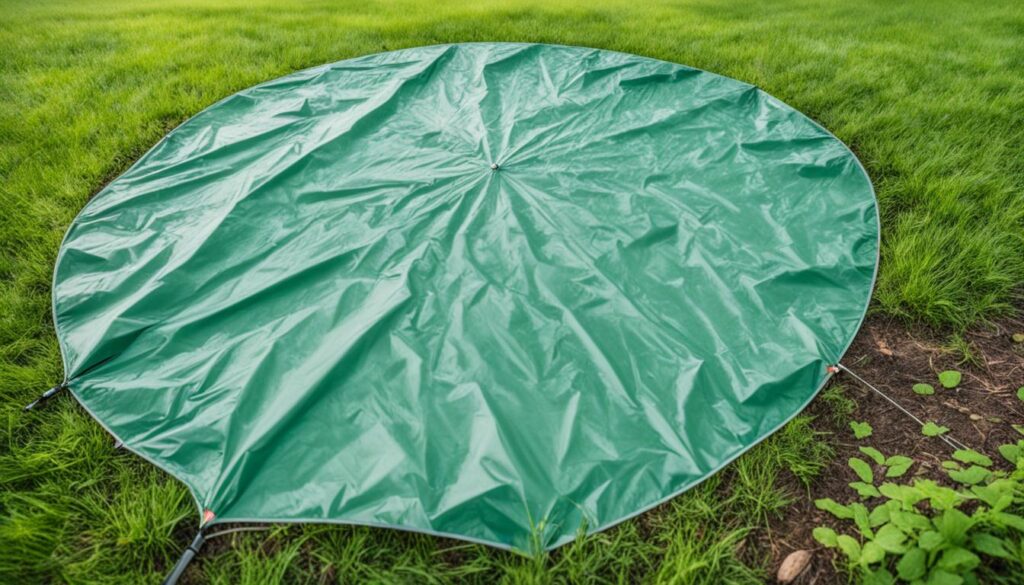Backpacking is thrilling and getting the right gear is key. A tent footprint is vital. It keeps your tent safe from damage. It’s perfect for best tent footprint for backpacking and more.
Key Takeaways
- Tent footprints protect your tent from wear and tear.
- Choosing the right one helps maximize protection.
- Look for good quality, light weight, and easy setup footprints.
- It’s important to position and stake the footprint well for a better camping experience.
- Sometimes, you can find alternatives to tent footprints that work, like DIY options or going without.
What is a Tent Footprint?
A tent footprint is key for backpackers and nature lovers. It’s a waterproof sheet placed under your tent. This extra layer keeps your tent safe from damage and water. There are many sizes and shapes available to match various tents.
Definition and Purpose of a Tent Footprint
The purpose of a tent footprint is clear – it protects your tent’s bottom from the ground. A waterproof tent footprint keeps your tent’s fabric safe from rocks and sticks. It acts as a shield, making your tent last longer and stay strong.
Types of Tent Footprints
There are many types of tent footprints for different needs. You can find lightweight backpacking footprints and packable tent footprint tarpaulins. These are often made from materials like polyethylene or nylon. They’re both breathable tent footprint materials and easy-setup tent footprint designs.
Benefits of Using a Tent Footprint
A tent footprint brings several advantages for backpackers. It guards your tent, making it last longer and keeping it dry. It also creates a nice, flat place for your tent, improving comfort and stability. With compact tent footprint solutions and long-lasting tent footprint fabrics, they are great for any adventure.
Do You Need a Tent Footprint for Backpacking?
The choice to use a tent footprint varies for everyone. It depends on personal needs and preferences. Some factors can help you decide if a tent footprint is a good choice for your backpacking trips.
Factors to Consider When Deciding
The need for a tent footprint depends on where you’ll camp. If you will camp on soft, grassy areas, using a footprint might not be vital. But if the ground is rocky or rough, it can make a big difference. Also, consider your tent’s floor material. Its level of durability and denier rating can affect your decision.
Tent Floor Durability and Denier Rating
When deciding about a tent footprint, the denier rating is crucial. Tents with higher denier ratings, like 70D or higher, are very durable. They might not need a footprint for extra protection. But, if your tent has a lower denier rating, using a tent footprint can increase its life. It can also prevent damage like punctures or cuts.
Best Tent Footprint for Backpacking
A tent footprint keeps your tent safe during adventures, protecting it from damage and wear. It’s key to pick the right size and shape of tent footprint to enjoy the best benefits.
Choosing the Right Size and Shape
Choosing a tent footprint involves looking at factors like size and shape for top protection. It should be a bit smaller than your tent’s floor. This helps stop water from getting in and avoids wear and tear. Also, pick a shape that fits your tent, whether that’s rectangular or another shape.
Material Considerations
The material of a tent footprint affects how well it protects your tent. Pick one made from waterproof and tough materials, like coated nylon. Such materials act as a strong shield. Also, think about how light and easy to pack it is for your backpacking needs.
Ultralight and Compact Options
If you’re into lightweight gear, choose an ultralight and compact tent footprint. There are many options that are light and thin, keeping your gear load low. Find a tent footprint that’s made from durable materials and is easy to pack.
Setting Up and Caring for Your Tent Footprint
Getting your tent footprint right is key for a great backpacking trip. First, put the footprint down where you want to camp. Make sure it’s big enough for your tent and any extra gear. You need the footprint large enough to cover your tent space and keep other items dry.
Proper Positioning and Staking
Choosing the best spot and staking the tent footprint tightly matters a lot. Use strong stakes at each corner to keep it secure. This stops the footprint from moving, keeping your tent safe from the ground.
Maintenance and Cleaning Tips
It’s vital to keep your tent footprint in good shape. After using it, check for tears or too much dirt. Remove debris and clean with mild soap and water as needed. Always let it dry completely before storing. This care keeps your tent footprint protecting your gear well.
Alternatives to Using a Tent Footprint
Hikers often use a tent footprint to keep their backpacking tents safe. Alternatives to using tent footprints can work well too. If you choose not to use a tent footprint, make sure your tent is tough. This is a good choice if you usually pick safe campsites or camp in mild weather. If your tent’s floor is strong, you might not need a footprint. This is especially true if you camp in easy places or if your tent is not used often.
Going Without a Footprint
Deciding to camp without a tent footprint can be okay. A high-quality tent with a solid floor might protect itself just fine. This is true if you camp on ground that is not rough. However, it is crucial to check the ground for sharp objects to prevent floor damage.
DIY Tent Footprint Solutions
DIY tent footprint solutions are a great choice for budget-savvy or weight-conscious backpackers. Creating a footprint from materials like tarp or a ground cloth from an old tent is easy. These options offer good protection for your tent. Plus, they are cheaper and lighter than buying a footprint.
Terrain and Campsite Selection
When selecting a spot for your tent, think about the camping area. The ground where you’ll be hiking and setting up your tent matters a lot. Every outdoor surface risks damage to your tent’s floor, which can lead to tears or wear.
Considering the Camping Environment
A soft forest floor won’t harm your tent much. Yet, a rocky ground can tear it easily. So, picking the right spot is key for your tent’s safety.
Tips for Finding an Ideal Campsite
Look for flat ground that is soft and lacks sharp items. Avoid rough areas because they can damage your tent. Choose a place like a grassy field or a smooth campground for the best experience.
Cost and Weight Considerations
When picking a tent footprint for your backpacking, both cost and weight matter. Prices can differ a lot. You might pay more for a ready-made one than for materials to make your own.
Manufacturer vs. DIY Footprint Costs
Tent makers sell footprints that fit their tents perfectly but are costly. Making your own can save you bucks but might not fit as well or work as seamlessly.
Weight Implications for Backpacking
Tent footprint weight is key, especially for those trying to save every ounce while backpacking. Ready-made ones tend to be heavier but more durable. DIY ones can be lighter with the right choice of materials. Choose what’s best for your needs, considering how it might affect the footprint’s lifespan.
Recommended
- BEST BED TENT TO BLOCK OUT LIGHT FOR SLEEP
- BED TENT FOR TRAVEL: SLEEP COZY ON-THE-GO
- INDOOR BED TENT FOR CAMPING COMFORT & FUN

Meet Noah, the soul behind “Best Inflatable Tent” and a true wanderer at heart. Living the van life, Noah has turned his passion for exploring the great outdoors into a lifestyle, earning his living through organizing group travels that bring people closer to nature. With years of firsthand experience in the wild, Noah’s expertise in selecting and utilizing inflatable tents is unparalleled. Through this blog, he shares his profound knowledge and practical tips to help fellow adventurers find their perfect outdoor shelters. Noah’s commitment to delivering genuine, tested insights has made him a trusted authority in the camping community. Join him on this journey to discover the best inflatable tents that make the great outdoors feel like home.
